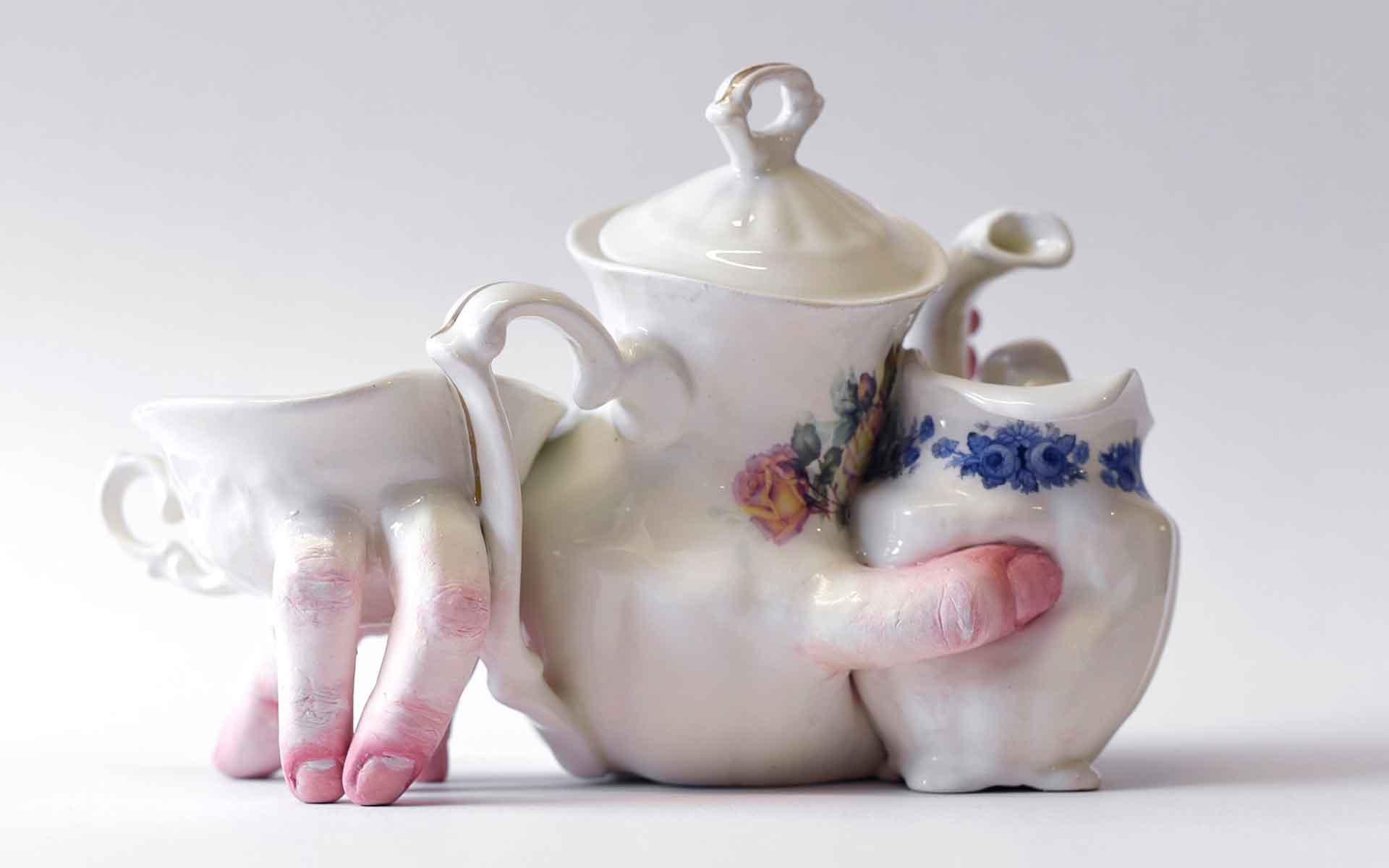
10 Jun Ceramics and The Macabre
When we combine ceramics and the macabre, we are not only challenging the way we perceive the art of pottery, but also daring to oppose the role of ceramics for their beauty, elegance and delicate nature. As I was growing up I had always associated ceramics objects with images of flowers or the occasion of afternoon tea, and I certainly never felt a strange, eerie sensation from a vase or teacup. For many centuries, dinnerware ceramics have portrayed wealth and status symbols; fine, porcelain plates ornately decorated with stereotypically feminine motifs and symbols, such as fruit, floral designs and birds, which may all connote beauty, virtue, love etc. The ceramics collection at the Victoria & Albert Museum in London illustrates this perfectly, there are over 15,000 objects to view in their online gallery to give you a broad overview of classical designs.
Ceramics and the macabre pursues a complete contrast to the traditional, conventional themes, resulting in unforgettable juxtapositions; love becomes death, virtue becomes sin, pleasure becomes pain. In recent decades, contemporary artists have pushed the boundaries and have evoked a range of emotion from their audience. Discomfort, revolt, fear and surprise are amongst the feelings commonly experienced with ceramics and the macabre. Although not all artworks require such an extreme reaction, some are simply created to tell new stories, explore bizarre, perhaps surreal images, the kind that we see in our dreams and leave us confused and perplexed. The following artists are powerful examples that teach us to follow our ideas, and trust our imaginations, without fear of criticism from a more traditionalist perspective. As the contemporary art scene grows, we learn that it is important to disrupt and reinvent, rather than to follow ideals of the past.
Sophie Aguilera-Lester
Sophie Aguilera is a Barcelona University graduate in Fine Arts inspired by ‘the human body to everyday objects’: Her work incorporates traditional motifs such as flowers and fruit along with figurative aspects that create a disturbing context. Her piece entitled Bajo las Maragaritas is a playful, yet eerie sculpture of a woman’s body buried beneath a plot of thriving daisies. In my opinion, her work opens up many questions regarding life and death whilst having a comical element of strangeness. Aguilera’s use of black, cream and brown soil are a stark contrast to the green, vibrant nature and hint of blue in the woman’s jacket, drawing focus to the two parallelising themes. Aguilera’s Corazón en Seis Actos is another powerful installation that evokes a more visceral and sensual response. Aguilera uses a matte pink glaze for the heart, which over the 6 acts, adopts a nauseating, diseased appearance, the surface is bubbling and discolouring as the heart shrinks.
Ronit Baranga
Ronit Baranga is an Israeli ceramist known for her macabre work combining beautiful tea sets and dinnerware with a dark, figurative twist. Her fascination for creating mouths and blood-red lips are beautifully sinister. There is no denying her skills as a figurative sculptor, her pieces dance between realism, surrealism and pure horror. Baranga’s contemporary ceramics are entitled ominous names such as “All things sweet and painful” and “Demon’s Playground”. Expect to see pale, vampirish babies, cupcakes that will bite you, and lots and lots of fingers! Her ideas may be thanks to her Psychology and Literature degree from Tel-Aviv University, then developed when studying Fine Art in Israel. Baranga’s work is a fascinating exploration of ‘emotional states and relationships’, executed with imagination and spine-tingling detail.


Lindsey Mendick
Lindsey Mendick is an emerging contemporary artist from the UK who is unafraid to create every wild and outrageous subject she pleases, her installations invite us into her world of monsters, fetish, along with the repulsive, yet strangely attractive appearances of rotting food. Mendick’s love of shock horror movies has influenced her conceptual ceramics in a huge way, and she has perfected the art of inspiring surprise, revolt, arousal and confusion. Underneath the surface, Mendick’s sculptures have been influenced by pivotal events in her life regarding mental health. Look out for her projects ‘Are you going to Destroy Me?’, ‘Hairy on the Inside” and ‘The Yellow Wallpaper”. Mendick’s contribution to ceramics and the macabre has an addictive vibrancy and light-heartedness that inspire and intrigue her audience.
Jessica Harrison
Jessica Harrison is an Edinburgh-based artist known for her provocative “Broken Ladies’’ series challenging a more traditional, feminised portrayal of women. Harrison takes found ceramics and cuts beneath the surface to reveal the organs and skeleton. Her ladies are often bleeding, suffering horrific wounds, whilst the original sweet smile of the figurine still remains. These ‘Broken Ladies’ create a new dialogue and a twist on the patriarchal fairytale, though it is not her intention to shock or unsettle her audience. Harrison seeks to explore the body, specifically the tactile and the visual aspects and how these two interact. By deconstructing the female figure, she is exposing the historical ‘taboos’ of women’s bodies, changing our perspective on a classically recognised porcelain figurine.
Kate Macdowell
Kate Macdowell is an American artist who primarily works with porcelain to hand-build ceramics to portray the relationship between the natural vs the human world in light of industrialisation and human impact on the environment. Her works create an awareness of the rapid rate of extinction amongst rare species. Her animal sculptures are given gas masks, protective goggles to humanise them and portray their own rights on the planet. Her sculpture “First and Last Breath” is a deeply powerful work showing a hare feeding its young whilst wearing a mask to protect her from pollution. Whilst the appearance of her pieces may not be disturbing, it is the truth behind her art that portrays the horrifying reality about mankind vs animals. Her ability to translate these messages through the language of ceramics is a testament to contemporary art.



If you’re interested in practising your ceramic decoration skills, 137° Ceramic Art studio offers ongoing weekly classes that explore a variety of inspiring techniques using glazes and coloured slips!
Written by Freya Saleh

